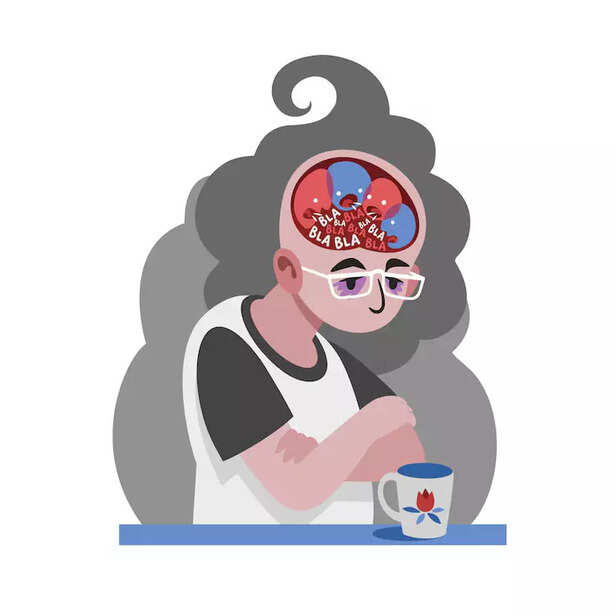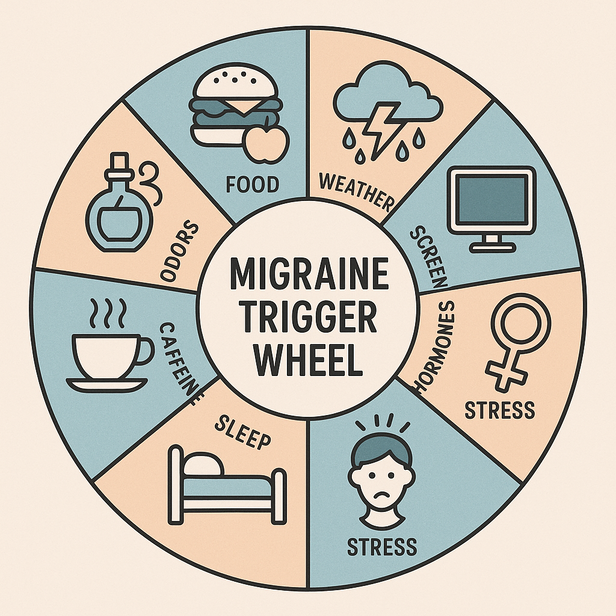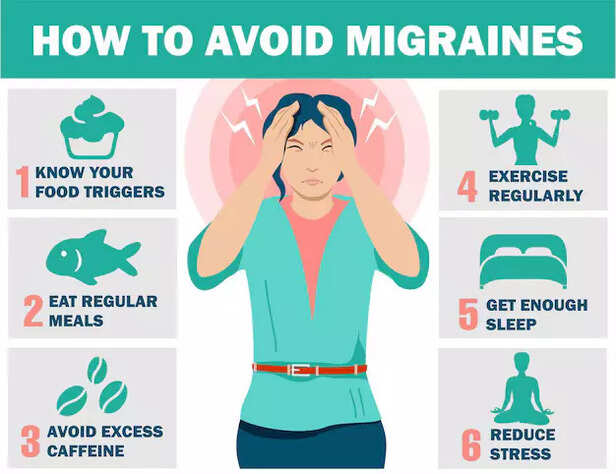Migraine Explained : What’s Really Going On in Your Head
Charu Sharma | Times Life Bureau | Jul 11, 2025, 23:55 IST
( Image credit : Times Life Bureau, Timeslife )
Migraines are more than just headaches - they’re complex neurological events involving multiple brain regions and phases. This article breaks down what truly happens during a migraine attack, from early warning signs (prodrome) to visual disturbances (aura), the intense pain phase, and the exhausting postdrome or “migraine hangover.” With clear explanations and visual suggestions, it helps readers understand the roots of migraines and how to manage the symptoms and not be afraid of the migraine attacks.
You’re in the middle of a meeting or walking with your friends , and suddenly, the lights seem too bright, sounds feel too loud, and a throbbing pain begins to build in your temples. It's not just a headache - it’s a migraine, and it’s your brain calling for help.
Migraines are a neurological condition that affect over 1 in 7 people globally (according to the American migraine foundation), yet they remain a topic which is so widely misunderstood and underdiagnosed. In this article, we’re diving into what actually happens inside your brain during a migraine - from the early warning signs to the hangover that follows. If you’ve ever asked yourself “Why is this happening to me?”, this might offer some answers.
Before the actual headache begins, many people experience the prodrome phase, which can start hours or even a day before the migraine hits the person. During this stage, there may be changes in the hypothalamus , the part of your brain that controls mood , appetite and your sleep cycle.
Common prodrome symptoms include :
Approximately 25% to 30% of people with migraines experience aura (according to American migraine foundation). Migraine aura refers to a collection of neurological symptoms that some people experience before or during a migraine headache. These auras are often visual disturbances, but can also include sensory, speech, or motor symptoms. They are typically temporary and reversible, and usually precede the headache phase, acting as a warning sign.
Aura symptoms can include:
Here comes the part which most people associate with migraines: the throbbing, one-sided headache that can last from 4 to 72 hours. It can cause throbbing pain or a pulsating sensation , generally on one side of the head. It's more than just a headache; it often includes other symptoms like nausea, vomiting, and sensitivity to light and sound. Migraines can be debilitating, and their exact cause is still being researched, but they are thought to involve nerve pathways and chemicals in the brain. This phase is triggered by the activation of the trigeminal nerve, which sends pain signals to the brain and leads to the release of chemicals like CGRP (Calcitonin Gene-Related Peptide). These chemicals cause inflammation and dilation of blood , which ultimately leads to intensification of the pain.
Typical symptoms:

Migraine hangover is the last stage of migraine .It is the final phase of a migraine attack , following the headache and aura (if present) . The brain slowly stabilizes after being hyperactive for hours or days. Also , neurochemical levels like serotonin may still be low, leading to fatigue or low mood. It's characterized by lingering symptoms that can last from a few hours to a couple of days, resembling the aftereffects of a traditional hangover.
Symptoms include:

Despite how common migraines are, scientists still haven’t found a single cause behind them. Instead, migraines are believed to be the result of a mix of environmental factors , genetics and lifestyle disorders. In other words, it’s a combination of things - not just one trigger that sets off a migraine in someone who is already sensitive.
Common triggers:

Living with migraines isn’t easy, but the good news is , there are certain ways to manage them. While there may not be a permanent cure (yet), combining the right lifestyle changes , medications and awareness of your triggers can significantly reduce the frequency and intensity of migraine attacks. The secret lies in understanding your body’s unique patterns, being gentle with yourself during hard days, and building a plan that works for you. Relief might not come overnight, but it does come - one smart step at a time.
Options include:
Migraine management is entirely personal - there is no measure that could fit all. What works for one might not work for the other. Every migraine sufferer has a different body, a different brain, and a different set of triggers and responses. You might still have tough days, but you’ll also discover tools, confidence, and resilience along the way and that can make all the difference.
So in the end : Understanding the science of migraines can be very validating. You're not imagining things and you're not overreacting. Your brain is experiencing a complex, multi-phase neurological event. The more we learn about migraines, the more compassion we can show, not just to others, but to ourselves. Whether you’re newly diagnosed or a long-time warrior, knowledge is your most powerful companion.
FAQs ( Frequently asked questions)
Migraines are a neurological condition that affect over 1 in 7 people globally (according to the American migraine foundation), yet they remain a topic which is so widely misunderstood and underdiagnosed. In this article, we’re diving into what actually happens inside your brain during a migraine - from the early warning signs to the hangover that follows. If you’ve ever asked yourself “Why is this happening to me?”, this might offer some answers.
1. It starts before the pain: The Prodrome Phase
Common prodrome symptoms include :
- Yawning excessively
- Mood changes (irritability or anxiety)
- Cravings (especially for sugar or salty foods)
- Neck and muscle pain
- Difficulty concentrating
- Sleep disturbances
2. Aura symptoms and the brain: what they’re telling you
Approximately 25% to 30% of people with migraines experience aura (according to American migraine foundation). Migraine aura refers to a collection of neurological symptoms that some people experience before or during a migraine headache. These auras are often visual disturbances, but can also include sensory, speech, or motor symptoms. They are typically temporary and reversible, and usually precede the headache phase, acting as a warning sign.
Aura symptoms can include:
- Flashing lights, zigzag patterns, or blind spots in vision
- Tingling or numbness in the limbs or face
- Difficulty speaking clearly
- Hearing buzzing or music
- Weakness or clumsiness in the limbs
3. The Pain Phase: when the storm hits
Here comes the part which most people associate with migraines: the throbbing, one-sided headache that can last from 4 to 72 hours. It can cause throbbing pain or a pulsating sensation , generally on one side of the head. It's more than just a headache; it often includes other symptoms like nausea, vomiting, and sensitivity to light and sound. Migraines can be debilitating, and their exact cause is still being researched, but they are thought to involve nerve pathways and chemicals in the brain. This phase is triggered by the activation of the trigeminal nerve, which sends pain signals to the brain and leads to the release of chemicals like CGRP (Calcitonin Gene-Related Peptide). These chemicals cause inflammation and dilation of blood , which ultimately leads to intensification of the pain.
Typical symptoms:
- Intense, pulsing pain (often one-sided)
- Nausea and vomiting
- Sensitivity to light (photophobia) and sound (phonophobia)
- Dizziness or blurred vision
4. The crash: Postdrome or the “Migraine Hangover”

Foggy and tired brain
( Image credit : Freepik )
Migraine hangover is the last stage of migraine .It is the final phase of a migraine attack , following the headache and aura (if present) . The brain slowly stabilizes after being hyperactive for hours or days. Also , neurochemical levels like serotonin may still be low, leading to fatigue or low mood. It's characterized by lingering symptoms that can last from a few hours to a couple of days, resembling the aftereffects of a traditional hangover.
Symptoms include:
- Brain fog
- Exhaustion and body aches
- Depression or emotional letdown
- Trouble focusing
- Mood changes
5. What causes it all? the Triggers and Theories

Migraine trigger wheel
( Image credit : Times Life Bureau )
Despite how common migraines are, scientists still haven’t found a single cause behind them. Instead, migraines are believed to be the result of a mix of environmental factors , genetics and lifestyle disorders. In other words, it’s a combination of things - not just one trigger that sets off a migraine in someone who is already sensitive.
Common triggers:
- Stress and anxiety
- Hormonal changes (especially in women)
- Skipping meals or dehydration
- Certain foods: alcohol and processed foods
- Changes in sleep pattern
- Weather changes or barometric pressure shifts
- Excessive screen time or bright lights
6. So, What Can You Do About It?

avoiding migraine
( Image credit : Freepik )
Living with migraines isn’t easy, but the good news is , there are certain ways to manage them. While there may not be a permanent cure (yet), combining the right lifestyle changes , medications and awareness of your triggers can significantly reduce the frequency and intensity of migraine attacks. The secret lies in understanding your body’s unique patterns, being gentle with yourself during hard days, and building a plan that works for you. Relief might not come overnight, but it does come - one smart step at a time.
Options include:
- Preventive medication (beta-blockers, anticonvulsants, CGRP inhibitors)
- Lifestyle strategies: regular sleep, hydration, limiting screen exposure, stress reduction
- Migraine diary: tracking symptoms, foods, sleep, cycle
- Alternative therapies: acupuncture, magnesium supplements, yoga, meditation
Migraine management is entirely personal - there is no measure that could fit all. What works for one might not work for the other. Every migraine sufferer has a different body, a different brain, and a different set of triggers and responses. You might still have tough days, but you’ll also discover tools, confidence, and resilience along the way and that can make all the difference.
So in the end : Understanding the science of migraines can be very validating. You're not imagining things and you're not overreacting. Your brain is experiencing a complex, multi-phase neurological event. The more we learn about migraines, the more compassion we can show, not just to others, but to ourselves. Whether you’re newly diagnosed or a long-time warrior, knowledge is your most powerful companion.
FAQs ( Frequently asked questions)
- Are there different types of migraines?Yes, including migraine with aura, without aura, chronic, and vestibular migraines.
- Can hormones affect migraines?Yes, hormonal changes during periods, pregnancy, or menopause can trigger migraines.
- How are migraines diagnosed ?Diagnosis is based on symptoms, medical history, and ruling out other conditions.
